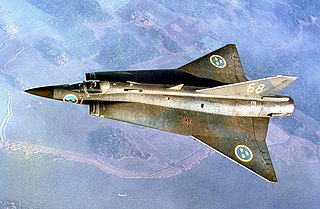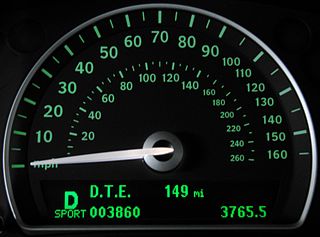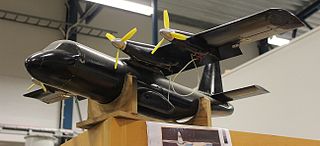
The Saab 900 is a mid-sized automobile produced by Swedish manufacturer Saab from 1978 until 1998 in two generations: the first from 1978 to 1994, and the second from 1994 to 1998.

The Saab 35 Draken is a Swedish fighter-interceptor developed and manufactured by Svenska Aeroplan Aktiebolaget (SAAB) between 1955 and 1974. Development of the Saab 35 Draken started in 1948 as the Swedish air force future replacement for the then also in development Saab 29 Tunnan day fighter and Saab 32B Lansen all-weather fighter. It featured an innovative but unproven double delta wing, leading to the creation of a sub-scale test aircraft, the Saab 210, which was produced and flown to test this previously-unexplored aerodynamic feature. The full-scale production version entered service with frontline squadrons of the Swedish Air Force on March 8, 1960. It was produced in several variants and types, most commonly as a fighter-interceptor.

The Saab 9-3 is a compact executive car initially developed and manufactured by the Swedish automaker Saab.

The Saab 9000 is an automobile produced by the Swedish company Saab from 1984 to 1998. Representing the company's foray into the executive car scene, it was developed as a result of the successes of the turbocharged 99 and 900 models. The 9000 remained in production until May 1998 and was replaced by the 9-5 in late 1997, although some final cars were produced into 1998. The Saab 9000 was only available with petrol engines, in two different 5-door hatchback designs or as a 4-door notchback.

The Saab 99 is a car produced by Swedish manufacturer Saab from 1968 to 1984; their first foray into a larger class than the Saab 96. While considered a large family car in Scandinavia, it was marketed as a niche compact executive car in most other markets. It was manufactured both in Sweden and Finland and was succeeded by the Saab 900, although the 99 continued to be produced alongside its successor. The Saab 90, an updated, less complex version using many 900 parts took over from the 99 in late 1984.

The Saab 9-5 is an executive car that was produced by the Swedish automobile maker Saab from 1997 to 2012.

The Saab 96 is an automobile manufactured and marketed by Swedish automaker Saab from 1960 to January 1980, replacing the Saab 93. The 96 featured aerodynamic two-door bodywork, four-passenger seating and at first a two-stroke, three-cylinder engine, later a four-stroke V4.

The Saab Sonett is an automobile manufactured by Swedish automaker Saab between 1955 and 1957 and again between 1966 and 1974. The Sonett share its engines and other mechanical components with the Saab 93, 95 and 96 of the same era. It was mainly intended for the lucrative American export market and was only offered intermittently in the Swedish domestic market for the 1968 and 1972 model years.

The Saab 340 is a Swedish twin-engine turboprop aircraft designed and initially produced by Saab AB and Fairchild Aircraft. It is designed to seat 30-36 passengers and, as of July 2018, there were 240 operational aircraft used by 34 different operators.

Saab Automobile AB was a car manufacturer that was founded in Sweden in 1945 when its parent company, Saab AB, began a project to design a small automobile. The first production model, the Saab 92, was launched in 1949. In 1968 the parent company merged with Scania-Vabis, and ten years later the Saab 900 was launched, in time becoming Saab's best-selling model. In the mid-1980s the new Saab 9000 model also appeared.

The Hofmeister kink is an automotive design feature consisting of a rearward/forward angle near the base of the rearmost pillar. It is named for Wilhelm Hofmeister, who was BMW's design chief from 1955 to 1970, though it appeared on other-brand cars made before Hofmeister's tenure at BMW.

The Saab B engine is an inline four-cylinder car petrol engine developed by Saab Automobile. A redesign of the Triumph slant-four engine, the B engine displaced 2.0 L and first appeared in 1972. The B engine was used in the Saab 99 and 900 models. Saab began to phase the engine out in 1981.

The Saab H engine is a redesign of the Saab B engine, which in turn was based on the Triumph Slant-4 engine.

A transverse engine is an engine mounted in a vehicle so that the engine's crankshaft axis is perpendicular to the direction of travel. Many modern front-wheel drive vehicles use this engine mounting configuration. Most rear-wheel drive vehicles use a longitudinal engine configuration, where the engine's crankshaft axis is parallel with the direction of travel, except for some rear-mid engine vehicles, which use a transverse engine and transaxle mounted in the rear instead of the front. Despite typically being used in light vehicles, it is not restricted to such designs and has also been used on armoured fighting vehicles to save interior space.

Haldex Traction is a manufacturer of intelligent all-wheel drive (AWD) systems, founded in Sweden. Since the invention of Gen I in 1998, the company produced several generations of products licensed to and customized for some major automotive brands, that in turn have marketed Haldex Traction AWD under different names. On 17 December 2010, American-based BorgWarner announced that it had signed an agreement to acquire the Traction Systems division of Haldex AB. BorgWarner completed the acquisition of the Traction Systems division on 1 February 2011. Haldex Traction Systems was incorporated in BorgWarner TorqTransfer Systems.

Saab Information Display (SID) later also called "Saab Car Computer" (SCC) is the name for various in-car computer systems found on most Saab automobiles beginning in 1985 with the Saab 9000 and followed in 1994 with the Saab 900 NG.

Hawtai is a Chinese automotive manufacturing company headquartered in Beijing, with production facilities in Ordos, Inner Mongolia, and Rongcheng, Shandong. Selling cars and SUVs under the Hawtai brand, from 2002 to 2010 the company had a joint venture or other form of legal cooperation with Hyundai Motors that manufactured Hyundai-brand passenger cars for the mainland China market; Hawtai continues to use some Hyundai technology today.

The Subaru Tribeca was a mid-size crossover SUV made from 2005 to 2014. Released in some markets, including Canada, as the Subaru B9 Tribeca, the car derives its name from the Tribeca neighborhood of New York City. Built on the Subaru Legacy platform and sold in five- and seven-seat configurations, the Tribeca was intended to be sold alongside a slightly revised version known as the Saab 9-6X. Saab, at the time a subsidiary of General Motors (GM), abandoned the 9-6X program just prior to its release subsequent to GM's 2005 divestiture of its 20 percent stake in FHI.

The Saab 107 was a proposed series of small airliners that were intended to be manufactured by Saab AB of Sweden, but were never built.

Saab Aero was the high-performance division of car manufacturer Saab Automobile. The Aero name refers to Saab's history as an aircraft manufacturer. The first Aero model was the 1984 Saab 900 Aero, and every subsequent model released by Saab was then offered with the optional Aero trim level. The final Aero model was the 2014 Saab 9-3, which was manufactured by the holding company NEVS. This was also the last time a Saab-branded vehicle has been manufactured by the holding company.




















